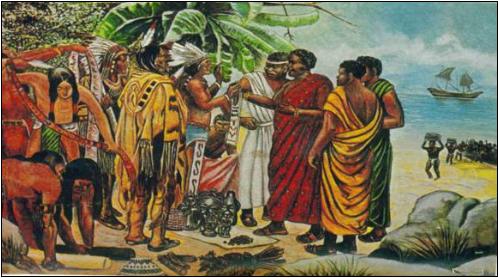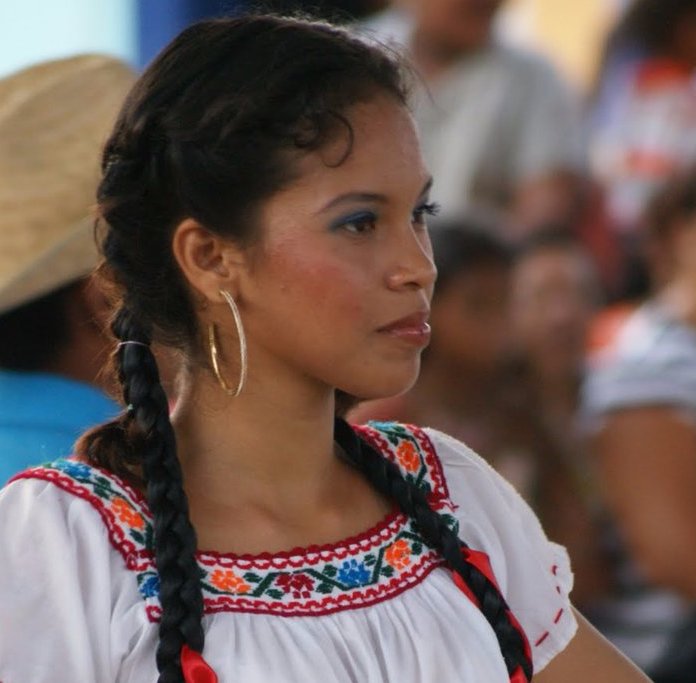Bogotá looked very white to me growing up. From the vantage point of that stretching meseta (plateau), tucked in between the high-rise ridges of the Andean range, the primarily brown, mestizo population of the altiplano cundiboyacense seemed to pine for pure European-ness. My own people, just generations before me, were European Jews, but I was born in Colombia and considered myself so.
As a white person, culturally Other in most of the places I’ve lived, I have come to realize that the desire to approximate white is prevalent amon the vast majority of former colonies, where the rulers were lighter-skinned than the populations they enslaved. This iniquity in power became institutionalized and encoded by color. As a wider range of skin tones spread across the globe through the plots of history, darker colors were relegated to the lowest spaces on totem poles and lighter ones to their peak.
The self-denial of Chibcha blood among my compatriots prepared me for the lightening creams I would, decades later, see being sold in South and East Asia, where proximity to whiteness is a coveted feature for both men and women. Fairness is also a prevalent narrative between regions of Africa, a continent so abused by foreign (read: white and powerful) involvement that it carries strongly to the African diaspora in Latin America, Europe, and the Caribbean. But I didn’t realize all of that yet.
When in social studies I learned about the caste system in pre-Gandhi India, it echoed with the logic of the Spanish Encomienda we studied in sociales, which sorted out people suited to progressively unpleasant tasks, according to a pre-charted gradient of skin. I memorized the human “recipes” the Spanish viceroys concocted for each rung on the labor ladder, as the people they imported and enslaved mixed with the ones who were already here.
I learned mestizos born were from white and indigenous parents; mulatos were the children of whites and Africans; zambos were the offspring of brown aborigines and black kidnapped slaves, the least valued members of society. I aced the vocabulary tests but failed to see real-life referents to the people these terms described.
Eventually, I would come to experience the distinct various regions of my own country, one that is roughly the size of Texas. When I travelled to the Caribbean coast, now I could see not only the African influences in the culture, cuisine, music, and actual color of the people, but also noticed the Middle Eastern influences from post-colonial immigrations. The Pacific coast of my country also bore the marks and labor of African slaves brought to develop the infrastructure and port industries of the region, while the southern regions were still rich with aboriginal customs and people. Bogotá was mestizo and white, but Colombia’s watercolor was a series of shades running into each other at their margins, dissolving into new hues, never-before-seen.
Imagine México, a country that once occupied roughly one third of the continent, is twice as big as Colombia, and also borders the Caribbean, ground zero for colonial slave trade. When I try to think about the African influence on Mexican culture, I come up empty, much like when I was young in Bogotá and the only tension seemed to be between whiteness and native American-ness. The strong traces of pre-Columbian cultures are seen as wide brushstrokes throughout the art, popular culture, and cuisine of México, which employs native ingredients and imports festivals and many brown words into the white culture inherited from Spain.
But when it comes to recognizing the contributions of African people into the prevailing culture, it is quickly apparent that history has been whitewashed. Nowhere is this more apparent than in the real and daily ways in which the widespread ignorance of the significant role that African influence plays through México, than in the lack of consideration given to the Afro-mestizo community.
African presence in México was felt around the beginning of the 16th century, when Spain transported just under a quarter of a million black people, predominantly from West Africa. It is calculated that between 1500 and 1600, one half of all African slaves were deposited in México, while the other half went all over South America. By the 1800, what amounted to hundreds of thousands of black Africans had arrived on Mexican shores, mostly in and around the port city of Veracruz.
This history has been largely hidden from view as it doesn’t appear in textbooks, says Abel Villanueva Hernández, advocate for “México Negro,” a collective that has fought to bring visibility to the Afro-mestizo population since the early 90s. When he searches his memory for evidence of African ancestry in the Mexican bloodline, he recalls a singular instance of seeing a photo of a black drummer, but only while visiting the state of Oaxaca, all the way in the south of the country.
This problem of perspective does not fade when seen from the ground. Since the official discourse in México struggles to include black Mexicans, so too are actual descendants of African people often ignorant of their own ancestral roots. Take the case of the town of Coyolillo, found within the state of Veracruz, that same area that served as the point of entry for the bulk of the slaves brought during La colonia. The town is today a hotbed for black activism, but only after enough young people like Daniela López Carreto have grown informed of their collective ancestry, rooted in African customs, like carnaval. Unsurprisingly, much like Villanueva Hernández, López Carreto first overheard this historical precedent while traveling outside of her hometown.
Despite being denied a rightful place in the history books, Afro-Mexicans are prominent in the pantheon of original Mexican heroes. Long before the revolt of the mestizos against Spain throughout the Latin American continent, an escaped slave known as Yanga waged three decades worth of war against the colonizers. In 1609, a few years before the Pilgrims arrived at Plymouth Rock, a town called San Lorenzo de los Negros, later known simply as Yanga, achieved independence from the Spanish oppressors, becoming the first free territory in all of the Americas.

Besides Yanga’s omission from the official chronicle of the nation, Méxican history does include the presence of Afro-Mexicans amongst the founding fathers of the nation. Both Vicente Guerrero, the sovereign nation’s second president, and José María Morelos, political strategist and military advisor, were both black. Much like in Alexander Hamilton’s, this fact is dissimulated by their frequent depiction of being unambiguously white, says Hugo Arellanes, activist with Huella Negra (Black Footprint). Unlike for Hamilton, no one has yet written a hip-hop musical that clarifies his ancestry and origin.
Instead, groups like Huella Negra, Sergio Peñaloza Perez’s México Negro, and López Carreto’s Casa Coyolillo are working to re-inscribe the Afro-Mexican experience into Mexican history and daily life. While López Carreto is prone to putting her very own image on the forefront of her fight for equal rights, choosing to wear her naturally curly hair out and visible, ready to prompt educational encounters with her peers, Peñaloza Perez’s work has been to open up channels of communication within anthropology and academia, paving the course for younger generations of researchers, like Gabriela Iturralde Nieto, to highlight the Afro-Mexican experience.
The very absence of a common, agreed-upon term to describe the Afro-Mestizo population in México is exactly the problem, thinks Iturralde Nieto, who points out that the rest of the continent has generated terms like African-American, Afro-Latino, or simply black. In México, there is now a push for the 2020 census to include and validate this precise construct — Afro-Mexican — for the sake of addressing an otherwise invisible population. Certainly, we are far from addressing a problem if we cannot even name it.
Efforts to increase media coverage of Afro-Mexicanos is part of the work carried out by advocacy groups, in addition to the struggle to get the black Mexican experience written into the official record. These initiatives look to give credit where it is due, such as when López Carreto realized how much of the carnaval ritual is inherited from Africa. But besides proper attribution, there are other human, ethical, and legal problems that arise from from the lack of recognition of the problems particular to Afro-Méxicanos, both those who look black and those who don’t.

Generally speaking, descendants from the African slaves continue to be trapped by their disproportionately large presence within the mid-lower and lower classes. Like that system of castas I learned about so long ago, Afro-Mexicanos continue to perform what is considered unskilled labor, such as agricultural jobs. If these institutionalized examples of discrimination were not enough, plenty of personal and individualized incidents are recorded, including but not limited to being called a witch due to her curly hair (López Carreto) or being denied her Mexican identity by those who thought her to look too black to be Mexican (Sósima Virgen, descendant of Yanga).n
The reality is that more than one million people in Mexico identify as black, whether their outward appearance reveals it or not. Those who do look black are too often subjected to discrimination, ranging from name-calling to police questioning, to full-fledged, Kafkaesque legal crises in which citizenship is questioned despite clear proof of it, in a futuristic-dystopia version of Jim Crow.
The southern state of Oaxaca includes one of the most sizable Afro-Mexican populations, a still tiny 5% of the state, garnering very little recognition, much less widespread knowledge and acceptance. In Oaxaca, a black Mexican musical artist named Chogo el Bandeño, avoided trouble with the police by being able to sing the national anthem (a few times) and answer multiple questions about current politics. His performance-defense convinced the cops to cease their badgering, but in other cases, black Mexicans in the region — especially women — have endured much more dire consequences.
There are roughly one and a half million Afro-Mexicans, accounting for a little over 1% nationwide. Meanwhile 10% of the population in México identifies as indigenous, and many more as mestizo. This has led to a few instances of black Mexicans being deported to Central America or Haiti, despite available and legal documentation of their mexicanidad. Though eventually resolved, there have been no reparations offered to the victims and assumption of culpability at the level of government or law-enforcement.
In fact, the refusal to identify Mexicans of African descent and culture as a minority within the large and diverse nation, is likely the largest contributor to the perpetuation of this racial bias. Acceptance at a level of language and discourse could only benefit Afro-Mexicans, who have so generously contributed to their nation. Since their arrival as slaves in that first part of the 16th centuries, many black Oaxaqueños have been dextrous ranchers, managing large animals when the much smaller mestizos struggled to do so.
Many Afro-Mexicanos don’t demonstrate the outward features of being black and their skin tone might be indistinguishable from a mestizo. But a portion of Mexican people feel black and carry on customs and cultural markers brought over from Africa or developed within black communities during their time in México. The dance and musical style called chileno, for instance, serves black musicians who borrow from Chilean sailors that passed through Oaxaca and adapt it to their own folklore.
There are African drums present in music that come from the region, as well as the use of an instrument called quijada, wrought from the jawbone of a donkey and one of its molars. The Dance of the Devils, performed around the Day of the Dead, is also a regional example of black influence. Members of the Afro-Mexican communities are proud of this heritage and feel that endorsement from the country at large is necessary for them to be recognized and stop being discriminated against.
These popular contributions are palpable in the arena of dance and music, including many other regions of the country. “La Bamba”, an example of jarocho music and claimed by Afro-Mexicans, is said to be named after the city of Bamba, Congo. The word itself describes the musical genre, the region of Veracruz, and, in some cases, is a synonym for black person.
Other African and Creole influences are also visible in regions to the north of Veracruz, where these unique styles of storytelling and passing on of folktales is seen in the Mexican corridos. World-famous La Cucaracha from Chihuahua is one of these, listing its various acts of civil disobedience and formerly used by the revolutionary army of Pancho Villa as a marching tune.
Less revolutionary are the presence of African facial features in Mexican art from early depictions of the Olmec tribe, colonial art, all the way to some of Frida Kahlo’s later works, such as “Diego, Me, and Señor Xolotl.” African influence has been present in art from colonial times through contemporary ones, on both sides of the brush. As early as the 1700s, the so called “caste painters” of Mexico began depicting the mixed-race children they imagined would emerge from the miscegenation of the colonies.
The 1700s also saw a literal collaboration between black Mexican and Spanish proselytizers, as mulatto “confraternities” began to emerge in the orbit of churches in every town with Afro-Mexican presence. Thinking that the adoption of Catholicism would help them assimilate into society, blacks and mulattos attended social and religious events in these community centers. Eventually, though American-born Afro-Mexicans lost their connection back to Africa, they still clung to some religious artifacts, which they blended seamlessly with local, emerging religious customs.
Much like black people are not recognized by the overriding culture in Mexico, so too do plantains invisibly thicken and make richer a mole, one of Mexican cuisine’s mother sauces. But plantains are African and their use in Mexican cuisine, together with that of root vegetables in trans-American cuisine and peanuts specifically in Veracruz, is concrete proof of African presence and influence. According to food expert, Zarela Martinez, tubers and roots like potatoes, malanga, and taro, conjure up the comfort of space kitchens throughout all levels of Mexican society today.
With all these contributions and clear paths of historical crossings and influences, the Mexican descendants of Africans require recognition in a nation they’ve helped to develop. Africans fought for Mexican independence from Spain, not only to achieve national sovereignty, but to ease domestic acceptance, yet hundreds of years later they are still waiting for that acceptance and support. Community leaders descended from these early revolutionaries and intellectuals, people like Yanga and Guerrero, and Morelos, are beginning to fear it will take another revolution to get their people the attention they deserve.
For Image credit or remove please email for immediate removal - info@belatina.com





































